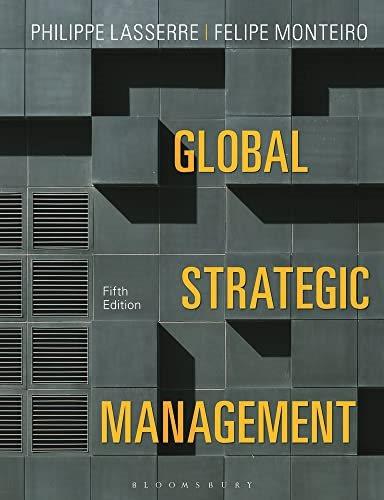Siemens is a global electronics and electrical engineering corporation, operating in energy, healthcare, infrastructure and industrial solutions
Question:
Siemens is a global electronics and electrical engineering corporation, operating in energy, healthcare, infrastructure and industrial solutions sectors. Founded in Germany in 1925, the company has 385,000 employees working at 1,640 locations around the globe, including 176 R&D facilities. Its revenue in 2019 was €86.849 billion. As of 30 September 2019, Siemens held approximately 68,300 granted patents, had 6,850 inventions and 3,750 patent applications pending.
There were on average 45,100 employees that worked in R&D in 2019, in 44 countries including 14,100 in Germany. R&D expenditures climbed to
€5.7 billion in fiscal year 2019, up from €5.6 billion in fiscal year 2018.
Its research and development activities were geared towards developing innovative, sustainable solutions for its customers – and the Siemens businesses.
Joint implementation of its operating units and Corporate Technology, the firm’s central R&D department, ensures that research activities and business strategies are aligned. These units also benefit equally and in a speedy manner from new technological developments. Siemens focused on technologies including additive manufacturing, autonomous robotics, blockchain applications, connected (e-)mobility, connectivity and edge devices, cyber security, data analytics and artificial intelligence, distributed energy systems, energy storage, future of automation, materials, power electronics, simulation and digital twins, and software systems and processes.
Further technologies are currently being developed through its ‘open innovation’ concept. They work closely with scholars from leading universities and research institutions with the focus on its strategic research partners, and especially its eight Centres of Knowledge Interchange that they maintain at leading universities worldwide. Siemens’
global venture capital unit, Next47, provides capital to help start-ups expand and scale and serves as the creator of next-generation businesses for Siemens by building, buying and partnering with innovative companies at any stage.
Technology Technology (T) is the central in-house research unit at Siemens. T works alongside the business units to drive forward the basic technologies that are important for the company as a whole.
These core technologies are crucial to the longterm success of Siemens and its customers. Experts from the global research department of T and the various businesses work together here, consolidating the company’s R&D activities.
The global network of experts comprises 2,400 employees, including 1,700 researchers and 350 patent experts. It acts as a strategic partner to support the executive units with R&D services, protect the company’s intellectual property and coordinate the collaboration with top universities worldwide.
The main locations are in Germany, Austria, the US, China, Russia, and India.
R&D at BASF17 BASF SE is a German multinational chemical company founded in 1865. BASF is an acronym for Badische Anilin und Soda Fabrik (German for ‘Baden Aniline and Soda Factory’). BASF Group is made up of subsidiaries and joint ventures in more than 80 countries and operates in 6 integrated production sites and 390 other production sites in Europe, Asia, Australia, the Americas and Africa. Headquartered in Ludwigshafen, Germany, BASF has customers in over 190 countries and supplies products to a wide variety of industries.
At the end of 2019, the company employed more than 117,000 people, with over 54,000 in Germany. In 2019, BASF posted sales of €59.3 billion and income from operations before special items of €4.5 billion.
BASF’s portfolio is made up of six segments:
Chemicals, Materials, Industrial Solutions, Surface Technologies, Nutrition & Care and Agricultural Solutions.
The company is organized into 11 divisions that are grouped into 6 segments based on their business models. These divisions are responsible for operations and organized according to sectors or products. They manage the 54 global and regional business units developing strategies for the 76 strategic business units.
The regional and country units represent BASF locally, supporting the growth of the operation divisions in proximity to customers. The regional divisions are organized into four regions: Europe, North America, Asia Pacific, and South America, Africa, Middle East.
Eight global units form the corporate centre that is accountable for group-wide governance and supports BASF’s Board of Executive Directors. Four global cross-functional service units offer services for individual sites or globally for business units of the BASF Group.
BASF has three global research divisions that are run from the group’s key regions – Europe, Asia Pacific and North America: Process Research &
Chemical Engineering (Ludwigshafen, Germany), Advanced Materials & Systems Research (Shanghai, China) and Bioscience Research (Research Triangle Park, North Carolina). Together with the development units in the operating divisions, they form the core of the global Know-How Verbund.
BASF developed a management approach called Verbund that integrates manufacturing and research. Production plants at large sites are closely interlinked and, in addition, the byproducts of one plant can be used as the starting materials of another. BASF considers that Verbund is the foundation of its competitiveness in all regions.
The group operates six Verbund sites as well as 361 additional production sites in more than 90 countries that ‘create chemistry – around the globe’.
Questions:
1 How does the global management of R&D at Siemens and BASF compare?
2 What are the potential benefits of the Verbund concept?
Step by Step Answer:

Global Strategic Management
ISBN: 9781350932968
5th Edition
Authors: Philippe Lasserre, Felipe Monteiro





